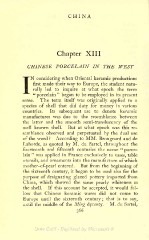Page 448 - Oriental Series Japan and China, Brinkly
P. 448
CHINA
Chapter XIII
CHINESE PORCELAIN IN THE WEST
considering when Oriental keramic productions
first made their way to Europe, the student natu-
INrally led to inquire at what epoch the term
" " employed in
began to be its present
porcelain
sense. The term itself was originally applied to a
species of shell that did duty for money in various
countries. Its subsequent use to denote keramic
manufactures was due to the resemblance between
the latter and the smooth semi-translucency of the
well known shell. But at what epoch was this re-
semblance observed and perpetuated by the dual use
of the word ? According to MM. Brongnard and de
Laborde, as quoted by M. du Sartel, throughout the
"
fourteenth and fifteenth centuries the name porce-
lain " was applied in France exclusively to vases, table
utensils, and ornaments into the manufacture of which
mother-of-pearl entered. But from the beginning of
the sixteenth century, it began to be used also for the
purpose of designating glazed pottery imported from
China, which showed the same pearly whiteness as
the shell. If this account be accepted, it would fol-
low that Chinese keramic wares did not come to
Europe until the sixteenth century ; that is to say,
until the middle of the Ming dynasty. M. du Sartel,
366

